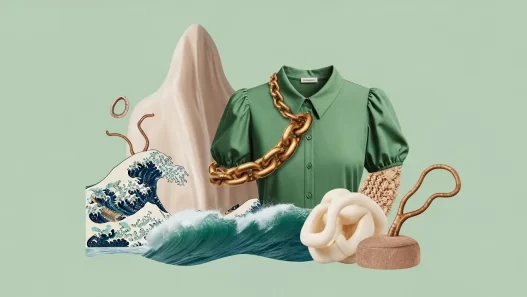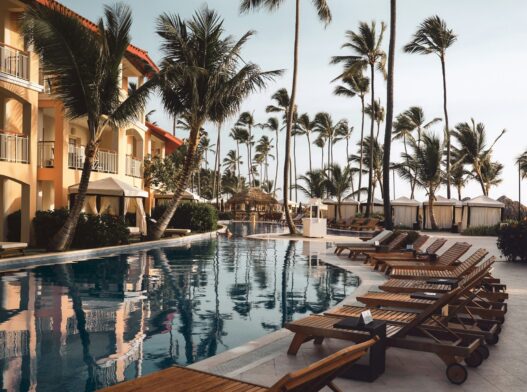“Fashion is not something that exists in dresses only. Fashion is in the sky, in the street. Fashion has to do with ideas, the way we live, what is happening.”
Coco Chanel said this decades ago. The quote continues to live and breathe in the industry’s core today. Fashion is not just apparel. It emerges from a sense of origin. A feeling of alignment with what you admire, what you aspire to become part of. It is in what you carry on your wrist, in the textures you choose, in the brands you embody, and in the spaces you occupy.
Chanel saw this early, long before the market caught on. That fashion would eventually shape the environment around us, not just metaphorically, but structurally.
Today, her vision reads less like a quote and more like a blueprint. We are now witnessing that very environment rise in the form of branded towers, spas, and residences. The Burj Khalifa isn’t just a marvel of architecture. It’s a luxury symbol, housing the Armani Suites as a literal extension of fashion into the skyline and concrete. The clothing label has become an interior experience: a place you don, inhabit, and Instagram.
In this article, we dissect that shift. We look at how seasonal drops no longer define the fashion industry, but by the architecture of desire. We trace how brand strategy has evolved to shape how luxury is consumed, remembered, and lived.
Emotional ROI Begins with Atmosphere
Studies across consumer psychology have shown that multisensory experiences heighten emotional resonance and brand perception, which is why, even today, luxury brands are hyper-specific in their franchise agreements. The scent to be diffused in the room, the music to be played, the shade of paint on the walls, the uniforms of the staff —none of it is left to chance. Every sensory element becomes a signature.
From scent, the industry moved into cafés. This marked the beginning of what we now understand as the experiential economy. Armani Caffè in Milan, Dior Café in Seoul, Ralph’s Coffee in New York, these were not just commercial outlets. They were narrative spaces. The journey from walking past to walking into these cafés was choreographed to remind you that you were welcome, that you belonged inside their world. That your aspirations were valid. Maybe even arriving. These spaces were branded down to the last spoon. The intention was never just to serve food. They were serving aesthetic immersion.
These were not gimmicks. They were testbeds. Carefully designed environments that predicted the next logical leap, with data and demand backing them. The success of these ventures revealed something foundational: the emotional ROI of experience was far higher than that of product. And from there, the magnanimous leap into full-scale hospitality was not just inevitable. It was strategic.
The Fashion Industry’s Real Estate Move
The perspective was not about building creative indulgence for the brands; instead, it was a calculated businessman approach. Numbers from Savills present that branded residences, which are essentially homes available for ownership or rental and built by developers with brand affiliation layered through design and service, have grown by over 160 per cent globally in the last decade. There are currently more than 690 completed projects, with another 600 in development as we speak.
In cities like Dubai, Bangkok, and Miami, known for being key touchdown points for global investors, branded homes command premiums up to 30 per cent higher than their unbranded counterparts. It would be an understatement to call this mere aesthetic inflation. This is brand-backed real estate, and it comes with weight.
There are clearly defined wins for all parties. For the owner, it means prestige, a trophy property, the benefit of brand association, quality fit-outs, professional management, and a structure that is easy to rent or leave locked up. For the brand, it creates income from licensing fees, opens new rental product lines, and strengthens long-term customer relationships. For the developer, it offers a point of difference in an increasingly competitive market; it attracts a broader customer base, brings in design expertise and marketing leverage, and allows for early cash flow and potential price premiums.
LVMH is a strong example. With Louis Vuitton, Dior, and Fendi in its portfolio, the group has built out its hospitality presence through Cheval Blanc, the acquisition of Belmond, and the upcoming Louis Vuitton hotel in Paris. Hospitality has become one of its fastest-growing verticals. The group reported more than 84 billion euros in revenue in 2023, and its hospitality arm is projected to contribute over 10 per cent of total group earnings by the end of the decade.
At this rate of return, failing to enter or underestimating this space is not a strategic restraint; it is a missed opportunity.
Why Luxury Isn’t About Owning Anymore. It’s About Belonging.
Some things go beyond the flashy campaigns and world-building partnerships. Businesses survive on one fundamental truth: people still have to buy into the product or service being offered. And in the luxury segment, where high-ticket transactions dominate, every timeless trick from the psychology playbook is studied and executed to meet what the customer is seeking.
One of the most powerful drivers in this equation is perception. The psychology of luxury today isn’t only about ownership. It is about access. The average consumer may no longer feel the need to own a luxury item, but they still want to be part of the luxury story. They want to feel aligned with the family that the brand claims to represent.
Someone might not have a place or occasion to wear vintage Dior, even if they deeply admire it. But a night in the Dior Suite is a different proposition. It is a social declaration. It speaks to self-worth, aspiration, and the thrill of emotional indulgence. And it works brilliantly. That is emotional capital, executed with intelligence and finesse. It offers a curated identity, one that feels personal, performative, and aspirational at once. This is what behavioural economists refer to as symbolic consumption, when what you pay for says more than what it does. And we cannot demonise that kind of spending. It holds both function and meaning. It satisfies both utility and identity.
Gen Z and millennials, seen from a bird-eye view, are more self-aware and more socially expressive than the generations that came before. They are propelling this shift forward. For them, experience now outperforms ownership. Presence is worth more than possession. And nothing captures that more clearly than branded hospitality.
This Has All Happened Before: The Cultural Memory Behind Branded Spaces
And it’s an ode, to say the least, to how the industry is moving now. This is not new. It is a return.
To give some context, controversial or not, it is essential to understand how deeply these shifts are rooted in cultural history and how they continue to shape consumer perception. In 18th-century France, the aristocracy didn’t just spend on the modiste for the fanciest silhouettes and corsets. They splurged on creating their presence. From the salons of the elite to the reverence gained from acquiring certain estates, every detail of their appearance, every facet of their surroundings, became part of their brand.
In India, palatial luxury has long been revered. From early Mauryan influences to the regionally rich architecture of Rajasthan and Gujarat, the style was shaped by narrative and land. The Mughal period brought in Persian and Central Asian blends, transforming palace design into something hybrid and symbolic. These weren’t just dwellings. They were declarations.
Think of Mysore Palace with its Indo-Saracenic blend—Udaipur’s City Palace with its peacock mosaics and manicured gardens. Jaisalmer Fort is carved into golden sandstone. These structures were built not just with marble, but with meaning. Even their walls once held embedded gems and perfumed air. They were statements quietly powerful, yet impossible to miss. That legacy carried forward. The Taj Palace, the Rambagh Palace, and the private homes of Marwari industrialists were never just residences. They were designed to be remembered.
So when we speak of branded hospitality, it isn’t a new blueprint. It is a revival. A reinterpretation of legacy, now licensed, scaled, and reintroduced by the global fashion empires of today.
Final Thoughts
What’s safe to say is that luxury has successfully outgrown its boutique-limited era. It has become a universe in itself, built one brand at a time. Your lipstick comes from Dior. Your sheets are from Frette. Your suite from Louis Vuitton. Your dinner, your candle, your playlist, all curated by the same house. This is no longer a world where fashion simply dresses you. It surrounds you.
And this isn’t driven by marketing alone. It is a symphony composed across multiple fields, including law, design, branding, and psychology. Legal protections have adapted to this new format. Scents can be trademarked. Spatial arrangements can be registered. Lighting formulas and interior palettes, once considered ambience, are now recognised as intellectual property, rightly so, because real investment goes into crafting that atmosphere.
So next time you walk through a brand-curated lobby, know that it isn’t just an entrance. It is a licensed aesthetic. A designed emotion. A place built to hold meaning.
Zoom out, and the pattern becomes even clearer. What brands are protecting is not just design, but psychological territory. The memory, aspiration, and emotional space they occupy in the consumer’s mind is the real asset. That is what makes this model not only sustainable but scalable. Luxury doesn’t just create desire. It maintains it.



















